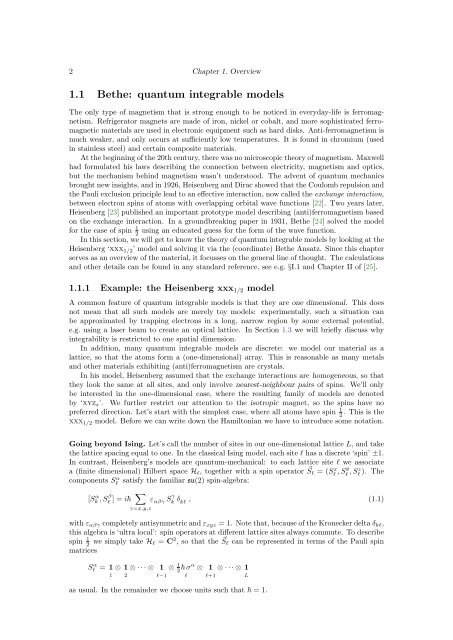The Bethe/Gauge Correspondence
The Bethe/Gauge Correspondence
The Bethe/Gauge Correspondence
Create successful ePaper yourself
Turn your PDF publications into a flip-book with our unique Google optimized e-Paper software.
2 Chapter 1. Overview1.1 <strong>Bethe</strong>: quantum integrable models<strong>The</strong> only type of magnetism that is strong enough to be noticed in everyday-life is ferromagnetism.Refrigerator magnets are made of iron, nickel or cobalt, and more sophisticated ferromagneticmaterials are used in electronic equipment such as hard disks. Anti-ferromagnetism ismuch weaker, and only occurs at sufficiently low temperatures. It is found in chromium (usedin stainless steel) and certain composite materials.At the beginning of the 20th century, there was no microscopic theory of magnetism. Maxwellhad formulated his laws describing the connection between electricity, magnetism and optics,but the mechanism behind magnetism wasn’t understood. <strong>The</strong> advent of quantum mechanicsbrought new insights, and in 1926, Heisenberg and Dirac showed that the Coulomb repulsion andthe Pauli exclusion principle lead to an effective interaction, now called the exchange interaction,between electron spins of atoms with overlapping orbital wave functions [22]. Two years later,Heisenberg [23] published an important prototype model describing (anti)ferromagnetism basedon the exchange interaction. In a groundbreaking paper in 1931, <strong>Bethe</strong> [24] solved the modelfor the case of spin 1 2using an educated guess for the form of the wave function.In this section, we will get to know the theory of quantum integrable models by looking at theHeisenberg ‘xxx 1/2 ’ model and solving it via the (coordinate) <strong>Bethe</strong> Ansatz. Since this chapterserves as an overview of the material, it focusses on the general line of thought. <strong>The</strong> calculationsand other details can be found in any standard reference, see e.g. §I.1 and Chapter II of [25].1.1.1 Example: the Heisenberg xxx 1/2 modelA common feature of quantum integrable models is that they are one dimensional. This doesnot mean that all such models are merely toy models: experimentally, such a situation canbe approximated by trapping electrons in a long, narrow region by some external potential,e.g. using a laser beam to create an optical lattice. In Section 1.3 we will briefly discuss whyintegrability is restricted to one spatial dimension.In addition, many quantum integrable models are discrete: we model our material as alattice, so that the atoms form a (one-dimensional) array. This is reasonable as many metalsand other materials exhibiting (anti)ferromagnetism are crystals.In his model, Heisenberg assumed that the exchange interactions are homogeneous, so thatthey look the same at all sites, and only involve nearest-neighbour pairs of spins. We’ll onlybe interested in the one-dimensional case, where the resulting family of models are denotedby ‘xyz s ’. We further restrict our attention to the isotropic magnet, so the spins have nopreferred direction. Let’s start with the simplest case, where all atoms have spin 1 2. This is thexxx 1/2 model. Before we can write down the Hamiltonian we have to introduce some notation.Going beyond Ising. Let’s call the number of sites in our one-dimensional lattice L, and takethe lattice spacing equal to one. In the classical Ising model, each site l has a discrete ‘spin’ ±1.In contrast, Heisenberg’s models are quantum-mechanical: to each lattice site l we associatea (finite dimensional) Hilbert space H l , together with a spin operator S ⃗ l = (Sl x, Sy l , Sz l). <strong>The</strong>components Slα satisfy the familiar su(2) spin-algebra:[Sk α , S β l ] = i ∑ε αβγ S γ k δ kl , (1.1)γ=x,y,zwith ε αβγ completely antisymmetric and ε xyz = 1. Note that, because of the Kronecker delta δ kl ,this algebra is ‘ultra local’: spin operators at different lattice sites always commute. To describespin 1 2 we simply take H l = C 2 , so that the ⃗ S l can be represented in terms of the Pauli spinmatricesS α l = 11⊗ 1 ⊗ · · · ⊗ 1 ⊗ 1 2 σα ⊗ 1 ⊗ · · · ⊗ 12l−1 l l+1Las usual. In the remainder we choose units such that = 1.
















